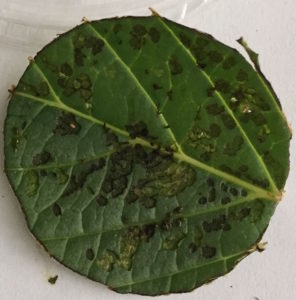Red Headed Flea Beetle Adults Active in NC
go.ncsu.edu/readext?459883
en Español / em Português
El inglés es el idioma de control de esta página. En la medida en que haya algún conflicto entre la traducción al inglés y la traducción, el inglés prevalece.
Al hacer clic en el enlace de traducción se activa un servicio de traducción gratuito para convertir la página al español. Al igual que con cualquier traducción por Internet, la conversión no es sensible al contexto y puede que no traduzca el texto en su significado original. NC State Extension no garantiza la exactitud del texto traducido. Por favor, tenga en cuenta que algunas aplicaciones y/o servicios pueden no funcionar como se espera cuando se traducen.
Português
Inglês é o idioma de controle desta página. Na medida que haja algum conflito entre o texto original em Inglês e a tradução, o Inglês prevalece.
Ao clicar no link de tradução, um serviço gratuito de tradução será ativado para converter a página para o Português. Como em qualquer tradução pela internet, a conversão não é sensivel ao contexto e pode não ocorrer a tradução para o significado orginal. O serviço de Extensão da Carolina do Norte (NC State Extension) não garante a exatidão do texto traduzido. Por favor, observe que algumas funções ou serviços podem não funcionar como esperado após a tradução.
English
English is the controlling language of this page. To the extent there is any conflict between the English text and the translation, English controls.
Clicking on the translation link activates a free translation service to convert the page to Spanish. As with any Internet translation, the conversion is not context-sensitive and may not translate the text to its original meaning. NC State Extension does not guarantee the accuracy of the translated text. Please note that some applications and/or services may not function as expected when translated.
Collapse ▲Originally posted on ecoipm.org
I got reports from Area Specialized Agent Danny Lauderdale that red headed flea beetle adults are active in eastern NC. Danny has been monitoring these pests closely and found active larvae in early March. Now, at just over 500 GDD in eastern NC, nurseries are starting to report adults.
Adult red-headed flea beetles are small, shiny black, beetles with reddish to dark colored heads, and long antennae. If you try to get a closer look and a small black insect, 1/8 of an inch long, and before you can see the red head it is gone, it’s probably a flea beetle. As the name suggests they jump great distances when approached. There are at least two generations in the Mid-Atlantic region and probably more in the South.
Favorite host plants of red-headed flea beetles include roses, forsythia, salvia, joe-pye weed, azaleas, and hydrangeas. Red-headed flea beetles skeletonize leaves usually leaving thicker leaf veins behind.
Red-headed flea beetles seem remarkably tolerant of insecticide residue. In our research, even relatively effective insecticides, such as dinotefuran, acephate, and some pyrethroids, which killed almost 100% of beetles the first day after application killed very few just a week or two later.
Other posts from our site and a great set of resources from Danny including a scouting video and article could help you manage these pests.



